Effectiveness of the Novel Rehabilitation Method of Seismically Damaged RC Joints Using C-FRP Ropes and Comparison with Widely Applied Method Using C-FRP Sheets—Experimental Investigation
Abstract
1. Introduction
2. Experimental Program
2.1. Test Specimens
2.2. Materials
2.3. Specimen Repair and Strengthening Procedure
2.4. Test Setup and Instrumentation
2.5. Loading History
2.6. Design of the Specimens
3. Test Results and Hysteretic Response
4. Evaluation of the Test Results
4.1. Damage Index
4.2. Equivalent Viscous Damping
5. Conclusions
Author Contributions
Funding
Institutional Review Board Statement
Informed Consent Statement
Data Availability Statement
Acknowledgments
Conflicts of Interest
References
- Li, S.; Shan, S.; Zhang, H. Rapid Retrofit of Reinforced Concrete Frames after Progressive Collapse to Increase Sustainability. Sustainability 2019, 11, 4195. [Google Scholar] [CrossRef]
- Gil-Martín, L.M.; Rodríguez-Suesca, A.E.; Fernández-Ruiz, M.A.; Hernández-Montes, E. Cyclic Behavior of RC Beam-Column Joints with Epoxy Resin and Ground Tire Rubber as Partial Cement Replacement. Constr. Build. Mater. 2019, 211, 659–674. [Google Scholar] [CrossRef]
- Ferreira, T.M.; Rodrigues, H.; Vicente, R. Seismic Vulnerability Assessment of Existing Reinforced Concrete Buildings in Urban Centers. Sustainability 2020, 12, 1996. [Google Scholar] [CrossRef]
- Manfredi, V.; Santarsiero, G.; Masi, A.; Ventura, G. The High-Performance Dissipating Frame (HPDF) System for the Seismic Strengthening of RC Existing Buildings. Sustainability 2021, 13, 1864. [Google Scholar] [CrossRef]
- Li, S.; Zhang, J. Retrofit Existing Frame Structures to Increase Their Economy and Sustainability in High Seismic Hazard Regions. Appl. Sci. 2019, 9, 5486. [Google Scholar] [CrossRef]
- Raza, S.; Khan, M.K.I.; Menegon, S.J.; Tsang, H.-H.; Wilson, J.L. Strengthening and Repair of Reinforced Concrete Columns by Jacketing: State-of-the-Art Review. Sustainability 2019, 11, 3208. [Google Scholar] [CrossRef]
- Karayannis, C.G.; Chalioris, C.E.; Sirkelis, G.M. Local Retrofit of Exterior RC Beam–Column Joints Using Thin RC Jackets—An Experimental Study. Earthq. Eng. Struct. Dyn. 2008, 37, 727–746. [Google Scholar] [CrossRef]
- Kalogeropoulos, G.I.; Tsonos, A.-D.G.; Konstantinidis, D.; Iakovidis, P.E. Earthquake-Resistant Rehabilitation of Existing RC Structures Using High-Strength Steel Fiber-Reinforced Concrete Jackets. Earthq. Struct. 2019, 17, 115–129. [Google Scholar] [CrossRef]
- Tran, M.-T.; Bui, Q.-B.; Sentosa, B.; Nguyen, N.-T.; Duong, T.-H.; Plé, O. Sustainable RC Beam-Column Connections with Headed Bars: A Formula for Shear Strength Evaluation. Sustainability 2018, 10, 401. [Google Scholar] [CrossRef]
- Bayhan, B.; Moehle, J.; Yavari, S.; Elwood, K.J.; Lin, S.; Wu, C.; Hwang, S. An Experimental and Analytical Study in Reinforced Concrete Frames with Weak Beam-Column Joints. In Proceedings of the 15WCEE, Lisbon, Portugal, 24–28 September 2012. [Google Scholar]
- Bayhan, B.; Moehle, J.; Yavari, S.; Elwood, K.; Lin, S.; Wu, C.; Hwang, S. Seismic Response of a Concrete Frame with Weak Beam-Column Joints. Earthq. Spectra 2015, 31, 293–315. [Google Scholar] [CrossRef]
- Kalogeropoulos, G.I.; Tsonos, A.-D.G. Improvement of the Cyclic Response of RC Columns with Inadequate Lap Splices-Experimental and Analytical Investigation. Earthq. Struct. 2019, 16, 279–293. [Google Scholar] [CrossRef]
- Mostofinejad, D.; Hajrasouliha, M. 3D Beam–Column Corner Joints Retrofitted with X-Shaped FRP Sheets Attached via the EBROG Technique. Eng. Struct. 2019, 183, 987–998. [Google Scholar] [CrossRef]
- Rossetto, T.; Pohoryles, D.; Miranda Melo, J.; Varum, H. The Effect of Slab and Transverse Beams on the Behaviour of Full-Scale Pre-1970’s RC Beam-Column Joints. In Proceedings of the 16th World Conference on Earthquake Engineering, Santiago, Chile, 9–13 January 2017. [Google Scholar]
- Yurdakul, Ö.; Avşar, Ö. Strengthening of Substandard Reinforced Concrete Beam-Column Joints by External Post-Tension Rods. Eng. Struct. 2016, 107, 9–22. [Google Scholar] [CrossRef]
- Pohoryles, D.A.; Melo, J.; Rossetto, T.; Varum, H.; Bisby, L. Seismic Retrofit Schemes with FRP for Deficient RC Beam-Column Joints: State-of-the-Art Review. J. Compos. Constr. 2019, 23, 03119001. [Google Scholar] [CrossRef]
- Bossio, A.; Fabbrocino, F.; Lignola, G.P.; Prota, A.; Manfredi, G. Simplified Model for Strengthening Design of Beam–Column Internal Joints in Reinforced Concrete Frames. Polymers 2015, 7, 1732–1754. [Google Scholar] [CrossRef]
- Kam, W.Y.; Quintana Gallo, P.; Akguzel, U.; Pampanin, S. Influence of slab on the seismic response of sub-standard detailed exterior reinforced concrete beam column joints. In Proceedings of the 9th US National and 10th Canadian Conference on Earthquake Engineering: Reaching Beyond Borders, Toronto, ON, Canada, 25–29 July 2010. [Google Scholar]
- Tsonos, A.G. Ultra-High-Performance Fiber Reinforced Concrete: An Innovative Solution for Strengthening Old R/C Structures and for Improving the FRP Strengthening Method. WIT Trans. Eng. Sci. 2009, 64, 12. [Google Scholar]
- Tsonos, A.G. Seismic Repair of Reinforced Concrete Beam-Column Subassemblages of Modern Structures by Epoxy Injection Technique. Struct. Eng. Mech. Int. J. 2002, 14, 543–563. [Google Scholar] [CrossRef]
- Golias, E.; Lindenthal, H.; Schlueter, F.-H.; Karabinis, A.I. Strengthening of Seismically Damaged Reinforced Concrete Beam-Column Joints by Means of FRP Rope Connections through the Joint Area. BAUTECHNIK 2020, 97, 268. [Google Scholar] [CrossRef]
- Karayannis, C.G.; Chalioris, C.E.; Sideris, K.K. Effectiveness og RC Beam- Column Connection Repair Using Epoxy Resin Injections. J. Earthq. Eng. 1998, 2, 217–240. [Google Scholar] [CrossRef]
- Karayannis, C.; Sirkelis, G. Effectiveness of RC Beam-Column Connections Strengthening Using Carbon-FRP Jackets. In Proceedings of the 12th European Conference on Earthquake Engineering, London, UK, 9–13 September 2002. [Google Scholar]
- Karayannis, C.G.; Sirkelis, G.M. Strengthening and Rehabilitation of RC Beam–Column Joints Using Carbon-FRP Jacketing and Epoxy Resin Injection. Earthq. Eng. Struct. Dyn. 2008, 37, 769–790. [Google Scholar] [CrossRef]
- Tsonos, A.-D.G.; Kalogeropoulos, G.I.; Iakovidis, P.E.; Konstantinidis, D. Seismic Retrofitting of Pre-1970 RC Bridge Columns Using Innovative Jackets. Int. J. Struct. Eng. 2017, 8, 133–147. [Google Scholar] [CrossRef]
- Karayannis, C.G.; Golias, E. Full Scale Tests of RC Joints with Minor to Moderate Seismic Damage Repaired Using C-FRP Sheets. Earthq. Struct. 2018, 15, 617–627. [Google Scholar] [CrossRef]
- Wang, B.; Gupta, R. Correlation of Electrical Conductivity, Compressive Strength, and Permeability of Repair Materials. ACI Mater. J. 2020, 117, 53–63. [Google Scholar] [CrossRef]
- Wang, B.; Gupta, R. Performance of Repaired Concrete under Cyclic Flexural Loading. Materials 2021, 14, 1363. [Google Scholar] [CrossRef] [PubMed]
- Durastanti, C.; Moretti, L. Environmental Impacts of Cement Production: A Statistical Analysis. Appl. Sci. 2020, 10, 8212. [Google Scholar] [CrossRef]
- Fujikake, K.; Mindess, S.; Xu, H. Analytical Model for Concrete Confined with Fiber Reinforced Polymer Composite. J. Compos. Constr. 2004, 8, 341–351. [Google Scholar] [CrossRef]
- Mahdavi, G.; Nasrollahzadeh, K.; Hariri-Ardebili, M.A. Optimal FRP Jacket Placement in RC Frame Structures Towards a Resilient Seismic Design. Sustainability 2019, 11, 6985. [Google Scholar] [CrossRef]
- Sharma, A.; Aneja, S.; Sharma, S.; Gupta, R. Elastic Wave Based Evaluation of CFRP Protected RC Structures Subjected to Corrosion. Constr. Build. Mater. 2021, 287, 123081. [Google Scholar] [CrossRef]
- Spadea, G.; Bencardino, F.; Swamy, R.N. Structural Behavior of Composite RC Beams with Externally Bonded CFRP. J. Compos. Constr. 1998, 2, 132–137. [Google Scholar] [CrossRef]
- Spadea, G.; Bencardino, F.; Swamy, R.N. Optimizing the Performance Characteristics of Beams Strengthened with Bonded CFRP Laminates. Mater. Struct. 2000, 33, 119–126. [Google Scholar] [CrossRef]
- Bencardino, F.; Spadea, G.; Swamy, R.N. Strength and Ductility of Reinforced Concrete Beams Externally Reinforced with Carbon Fiber Fabric. Struct. J. 2002, 99, 163–171. [Google Scholar] [CrossRef]
- Spadea, G.; Bencardino, F.; Sorrenti, F.; Swamy, R.N. Structural Effectiveness of FRP Materials in Strengthening RC Beams. Eng. Struct. 2015, 99, 631–641. [Google Scholar] [CrossRef]
- Pampanin, S.; Bolognini, D.; Pavese, A. Performance-Based Seismic Retrofit Strategy for Existing Reinforced Concrete Frame Systems Using Fiber-Reinforced Polymer Composites. J. Compos. Constr. 2007, 11, 211–226. [Google Scholar] [CrossRef]
- Tsonos, A.G. An Innovative Solution for Strengthening of Old R/C Structures and for Improving the FRP Strengthening Method. Struct. Monit. Maint. 2014, 1, 323–338. [Google Scholar] [CrossRef]
- Li, B.; Chua, H.Y.G. Seismic Performance of Strengthened Reinforced Concrete Beam-Column Joints Using FRP Composites. J. Struct. Eng. 2009, 135, 1177–1190. [Google Scholar] [CrossRef]
- Attari, N.; Amziane, S.; Chemrouk, M. Efficiency of Beam–Column Joint Strengthened by FRP Laminates. Adv. Compos. Mater. 2010, 19, 171–183. [Google Scholar] [CrossRef]
- Li, B.; Kai, Q. Seismic Behavior of Reinforced Concrete Interior Beam-Wide Column Joints Repaired Using FRP. J. Compos. Constr. 2011, 15, 327–338. [Google Scholar] [CrossRef]
- Sezen, H. Repair and Strengthening of Reinforced Concrete Beam-Column Joints with Fiber-Reinforced Polymer Composites. J. Compos. Constr. 2012, 16, 499–506. [Google Scholar] [CrossRef]
- Ha, G.-J.; Cho, C.-G.; Kang, H.-W.; Feo, L. Seismic Improvement of RC Beam–Column Joints Using Hexagonal CFRP Bars Combined with CFRP Sheets. Compos. Struct. 2013, 95, 464–470. [Google Scholar] [CrossRef]
- Kalogeropoulos, G.I.; Tsonos, A.-D.G.; Konstandinidis, D.; Tsetines, S. Pre-Earthquake and Post-Earthquake Retrofitting of Poorly Detailed Exterior RC Beam-to-Column Joints. Eng. Struct. 2016, 109, 1–15. [Google Scholar] [CrossRef]
- Tsonos, A.G. Effectiveness of CFRP-Jackets and RC-Jackets in Post-Earthquake and Pre-Earthquake Retrofitting of Beam–Column Subassemblages. Eng. Struct. 2008, 30, 777–793. [Google Scholar] [CrossRef]
- Del Vecchio, C.; Di Ludovico, M.; Balsamo, A.; Prota, A.; Manfredi, G.; Dolce, M. Experimental Investigation of Exterior RC Beam-Column Joints Retrofitted with FRP Systems. J. Compos. Constr. 2014, 18, 04014002. [Google Scholar] [CrossRef]
- Esmaeeli, E.; Barros, J.A.O.; Sena-Cruz, J.; Fasan, L.; Prizzi, F.R.L.; Melo, J.; Varum, H. Retrofitting of Interior RC Beam–Column Joints Using CFRP Strengthened SHCC: Cast-in-Place Solution. Compos. Struct. 2015, 122, 456–467. [Google Scholar] [CrossRef]
- Ghobarah, A.; Said, A. Shear Strengthening of Beam-Column Joints. Eng. Struct. 2002, 24, 881–888. [Google Scholar] [CrossRef]
- Realfonzo, R.; Napoli, A.; Pinilla, J.G.R. Cyclic Behavior of RC Beam-Column Joints Strengthened with FRP Systems. Constr. Build. Mater. 2014, 54, 282–297. [Google Scholar] [CrossRef]
- Hadi, M.N.S.; Tran, T.M. Retrofitting Nonseismically Detailed Exterior Beam–Column Joints Using Concrete Covers Together with CFRP Jacket. Constr. Build. Mater. 2014, 63, 161–173. [Google Scholar] [CrossRef]
- Hadi, M.N.S.; Tran, T.M. Seismic Rehabilitation of Reinforced Concrete Beam–Column Joints by Bonding with Concrete Covers and Wrapping with FRP Composites. Mater. Struct. 2016, 49, 467–485. [Google Scholar] [CrossRef]
- Garcia, R.; Jemaa, Y.; Helal, Y.; Pilakoutas, K.; Guadagnini, M. FRP Strengthening of Seismically Deficient Fullscale RC Beam-Column Joints. In Proceedings of the 15th World Conference on Earthquake Engineering, Lisbon, Portugal, 24–28 September 2012. [Google Scholar]
- Garcia, R.; Jemaa, Y.; Helal, Y.; Guadagnini, M.; Pilakoutas, K. Seismic Strengthening of Severely Damaged Beam-Column RC Joints Using CFRP. J. Compos. Constr. 2014, 18, 04013048. [Google Scholar] [CrossRef]
- Le-Trung, K.; Lee, K.; Lee, J.; Lee, D.H.; Woo, S. Experimental Study of RC Beam–Column Joints Strengthened Using CFRP Composites. Compos. Part. B Eng. 2010, 41, 76–85. [Google Scholar] [CrossRef]
- D’Ayala, D.; Penford, A.; Valentini, S. Use of FRP Fabric for Strengthening of Reinforced Concrete Beam-Column Joints. In Proceedings of the 10th International Conference on Structural Faults and Repair, London, UK, 1–3 July 2003. [Google Scholar]
- Faleschini, F.; Gonzalez-Libreros, J.; Zanini, M.A.; Hofer, L.; Sneed, L.; Pellegrino, C. Repair of Severely-Damaged RC Exterior Beam-Column Joints with FRP and FRCM Composites. Compos. Struct. 2019, 207, 352–363. [Google Scholar] [CrossRef]
- Lee, W.T.; Chiou, Y.J.; Shih, M.H. Reinforced Concrete Beam–Column Joint Strengthened with Carbon Fiber Reinforced Polymer. Compos. Struct. 2010, 92, 48–60. [Google Scholar] [CrossRef]
- Fujikake, K.; Soeum, S.; Matsui, T. CFRP Strengthened RC Beams Subjected to Impact Loading. Procedia Eng. 2017, 210, 173–181. [Google Scholar] [CrossRef]
- Chalioris, C.E.; Zapris, A.G.; Karayannis, C.G. U-Jacketing Applications of Fiber-Reinforced Polymers in Reinforced Concrete T-Beams against Shear—Tests and Design. Fibers 2020, 8, 13. [Google Scholar] [CrossRef]
- Raval, S.S.; Dave, U.V. Effectiveness of Various Methods of Jacketing for RC Beams. Procedia Eng. 2013, 51, 230–239. [Google Scholar] [CrossRef]
- Akguzel, U.; Pampanin, S. Analytical Model for Shear Strengthening of RC Beam-Column Joints Using Composite Materials. In Proceedings of the NZSEE Conference, Christchurch, New Zealand, 3–5 April 2009. [Google Scholar]
- Akgüzel, U.; Quintana Gallo, P.; Pampanin, S. Seismic Strengthening of a Non-Ductile RC Frame Structure Using GFRP Sheets. In Proceedings of the 9th Pacific Conference on Earthquake Engineering (PCEE 2011): Building an Earthquake-Resilient Society, Auckland, New Zealand, 14–16 April 2011. [Google Scholar]
- Roudsari, S.; Hamoush, S.; Soleimani, S.; Abu-Lebdeh, T.; HaghighiFar, M. Analytical Study of Reinforced Concrete Beams Strengthened by FRP Bars Subjected to Impact Loading Conditions. Am. J. Eng. Appl. Sci. 2018, 11, 407–425. [Google Scholar] [CrossRef]
- Sharma, S.S.; Dave, U.V.; Solanki, H. FRP Wrapping for RC Columns with Varying Corner Radii. Procedia Eng. 2013, 51, 220–229. [Google Scholar] [CrossRef]
- Al-Salloum, Y.A.; Almusallam, T.H. Seismic Response of Interior RC Beam-Column Joints Upgraded with FRP Sheets. I: Experimental Study. J. Compos. Constr. 2007, 11, 575–589. [Google Scholar] [CrossRef]
- El-Amoury, T.; Ghobarah, A. Seismic Rehabilitation of Beam–Column Joint Using GFRP Sheets. Eng. Struct. 2002, 24, 1397–1407. [Google Scholar] [CrossRef]
- Ghobarah, A.; Said, A. Seismic Rehabilitation of Beam-Column Joints Using FRP Laminates. J. Earthq. Eng. 2001, 5, 113–129. [Google Scholar] [CrossRef]
- Antonopoulos, C.P.; Triantafillou, T.C. Experimental Investigation of FRP-Strengthened RC Beam-Column Joints. J. Compos. Constr. 2003, 7, 39–49. [Google Scholar] [CrossRef]
- Karayannis, C.G.; Golias, E. Strengthening of Deficient RC Joints with Diagonally Placed External C-FRP Ropes. Earthq. Struct. 2021, 20, 123–132. [Google Scholar] [CrossRef]
- Karayannis, C.; Golias, E.; Chalioris, C. Local FRP-Retrofitting of Exterior Reinforced Concrete Beam-Column Joints under Cyclic Lateral Loading. In Proceedings of the 16th European Conference on Earthquake Engineering, Thessaloniki, Greece, 18–21 June 2018. [Google Scholar]
- Chalioris, C.E.; Kosmidou, P.-M.K.; Papadopoulos, N.A. Investigation of a New Strengthening Technique for RC Deep Beams Using Carbon FRP Ropes as Transverse Reinforcements. Fibers 2018, 6, 52. [Google Scholar] [CrossRef]
- Eurocode 8: Design of Structures for Earthquake Resistance-Part 1: General Rules, Seismic Actions and Rules for Buildings; European Committee for Standardization: Brussels, Belgium, 2005.
- American Concrete Institute. Building Code Requirements for Structural Concrete: (ACI 318-02) and Commentary (ACI 318R-02); American Concrete Institute: Farmington Hills, MI, USA, 2002. [Google Scholar]
- Tsonos, A.-D.G. Model for the Evaluation of the Beam-Column Joint Ultimate Strength-a More Simplified Version. Earthq. Struct. 2019, 16, 141–148. [Google Scholar]
- Park, Y.-J.; Ang, A.H.-S. Mechanistic Seismic Damage Model for Reinforced Concrete. J. Struct. Eng. 1985, 111, 722–739. [Google Scholar] [CrossRef]
- Cosenza, E.; Manfredi, G.; Ramasco, R. The Use of Damage Functionals in Earthquake Engineering: A Comparison between Different Methods. Earthq. Eng. Struct. Dyn. 1993, 22, 855–868. [Google Scholar] [CrossRef]
- Barros, M.H.F.M.; Martins, R.A.F.; Ferreira, C.C. Tension Stiffening Model with Increasing Damage for Reinforced Concrete. Eng. Comput. 2001, 18, 759–785. [Google Scholar] [CrossRef]
- Hafezolghorani, M.; Hejazi, F.; Vaghei, R.; Jaafar, M.S.B.; Karimzade, K. Simplified Damage Plasticity Model for Concrete. Struct. Eng. Int. 2017, 27, 68–78. [Google Scholar] [CrossRef]
- Grassl, P.; Jirásek, M. Damage-Plastic Model for Concrete Failure. Int. J. Solids Struct. 2006, 43, 7166–7196. [Google Scholar] [CrossRef]
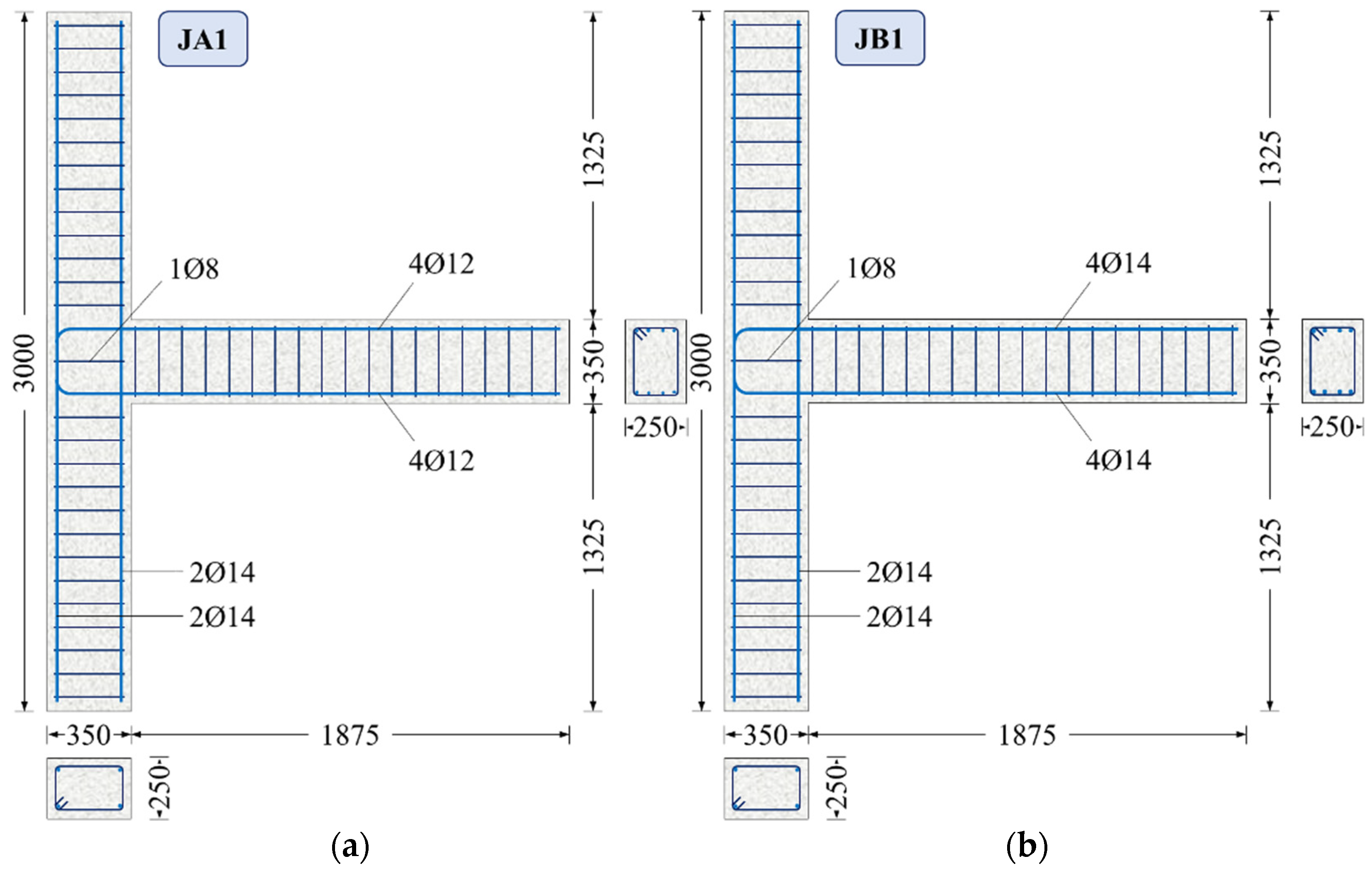
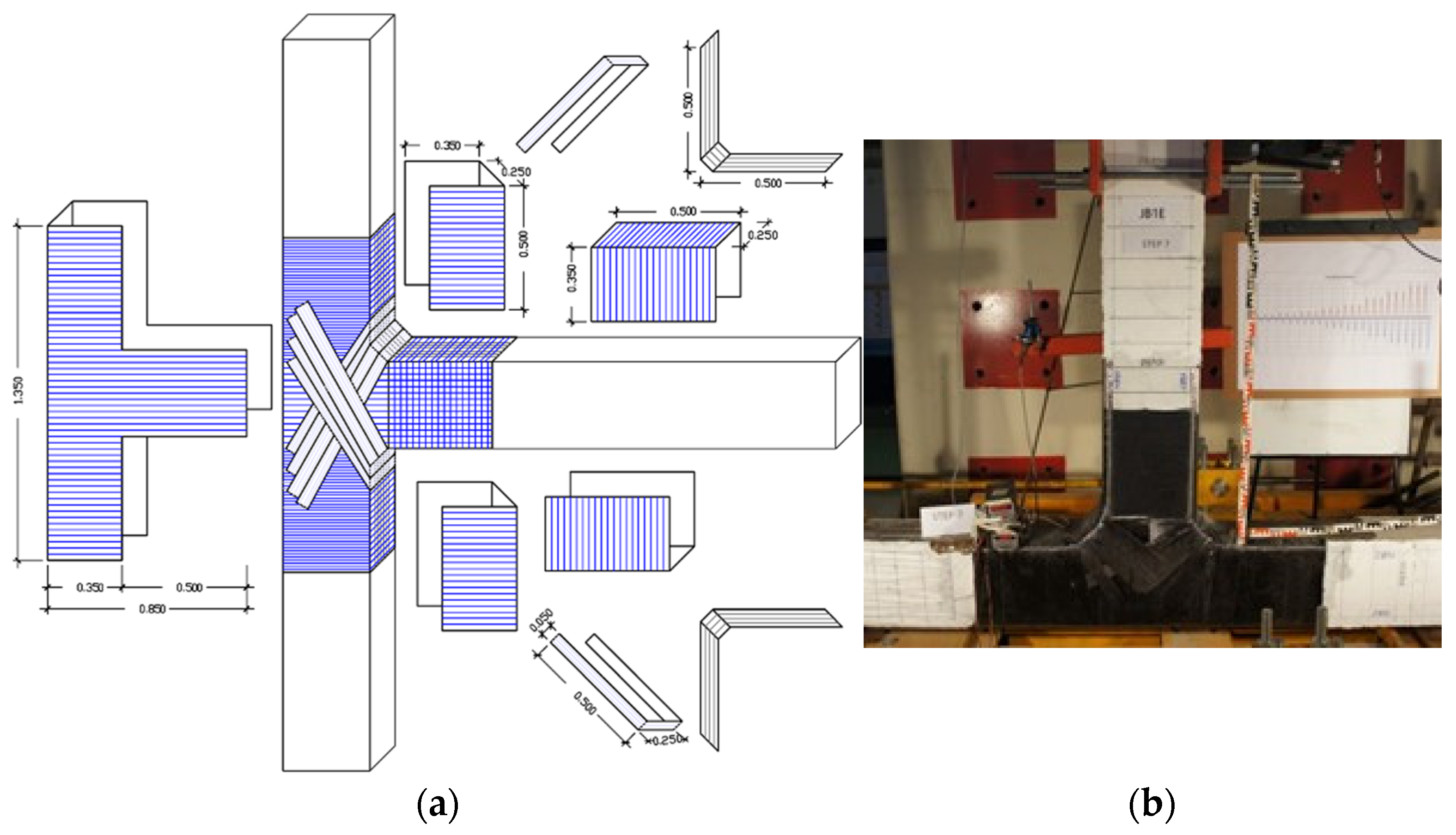
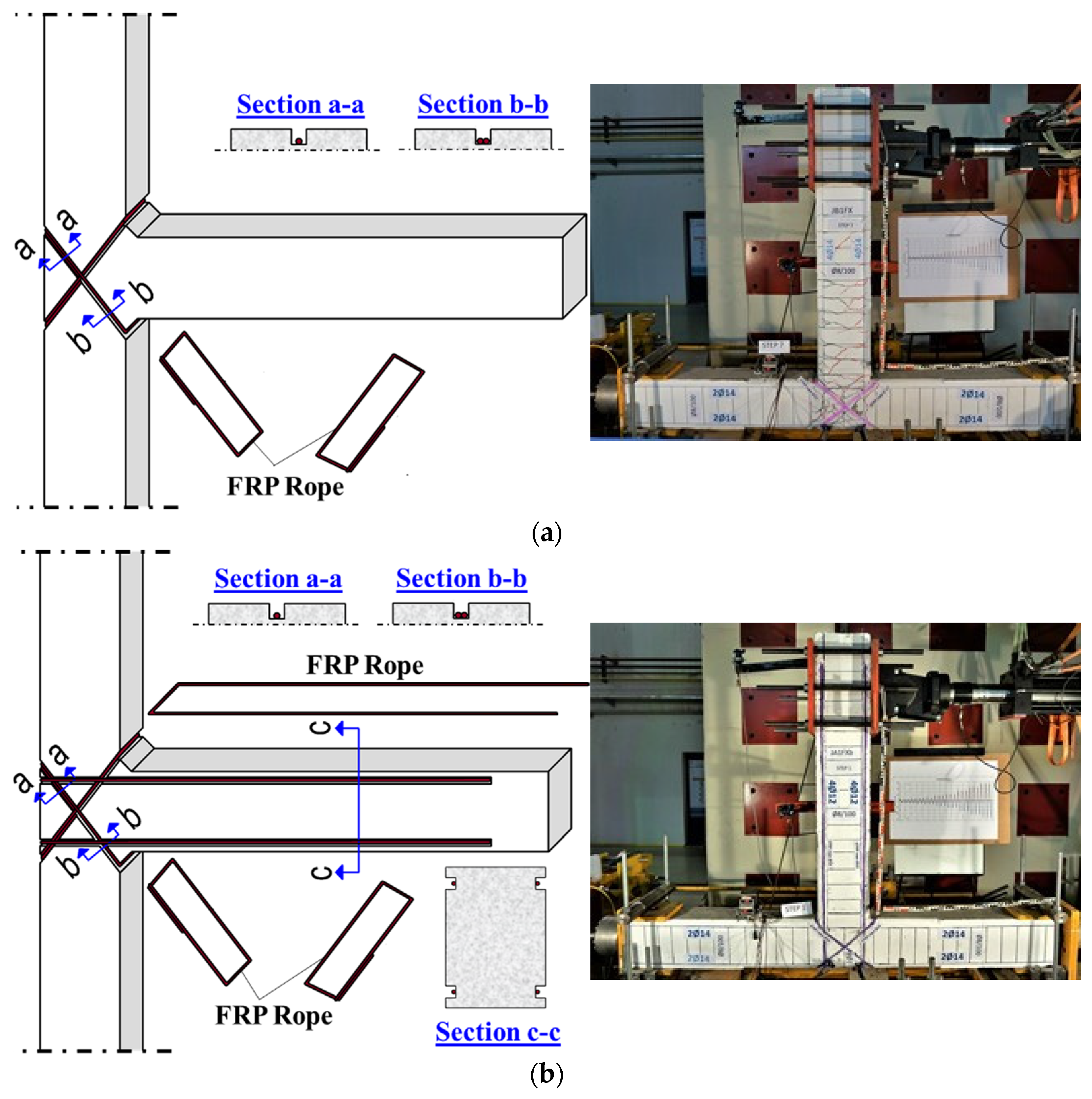

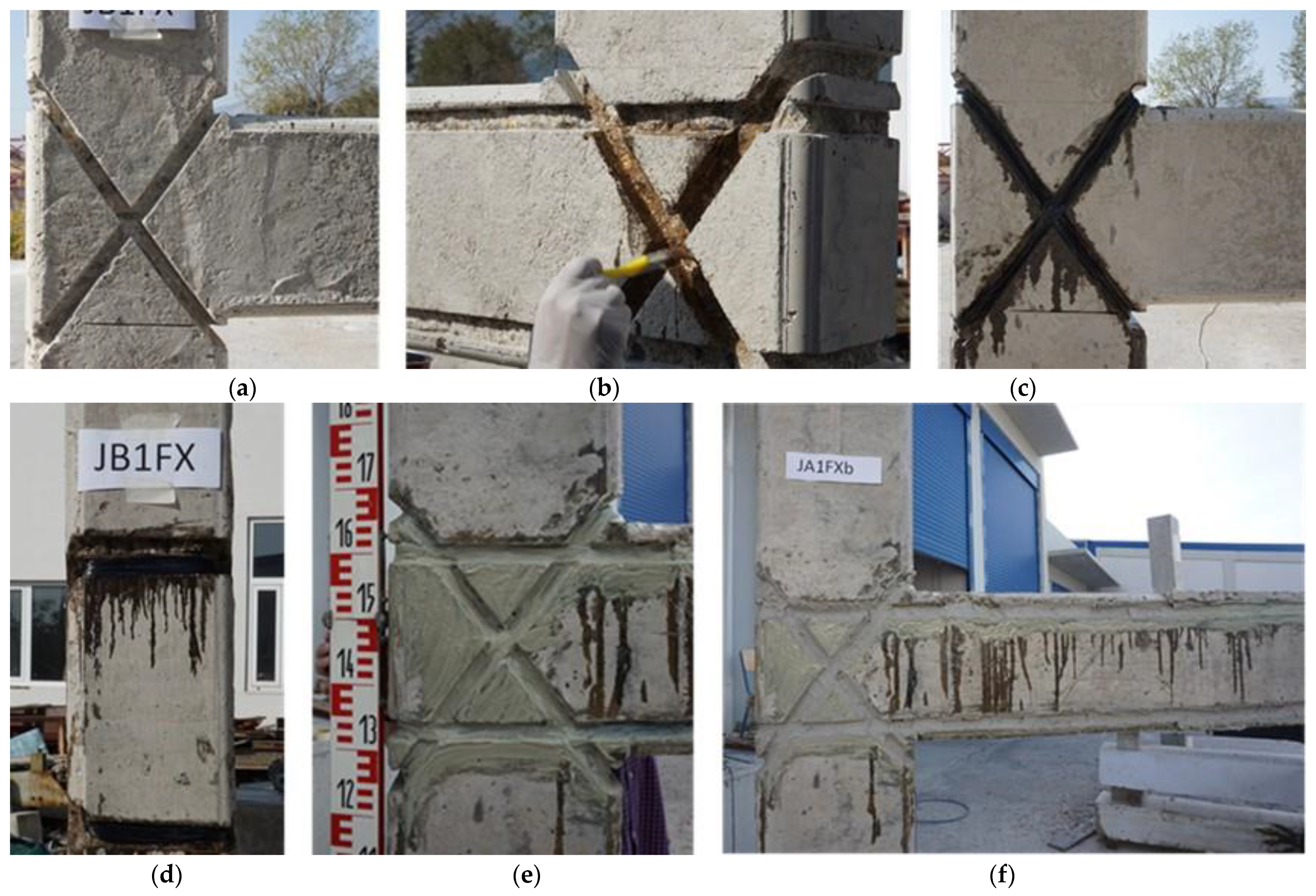
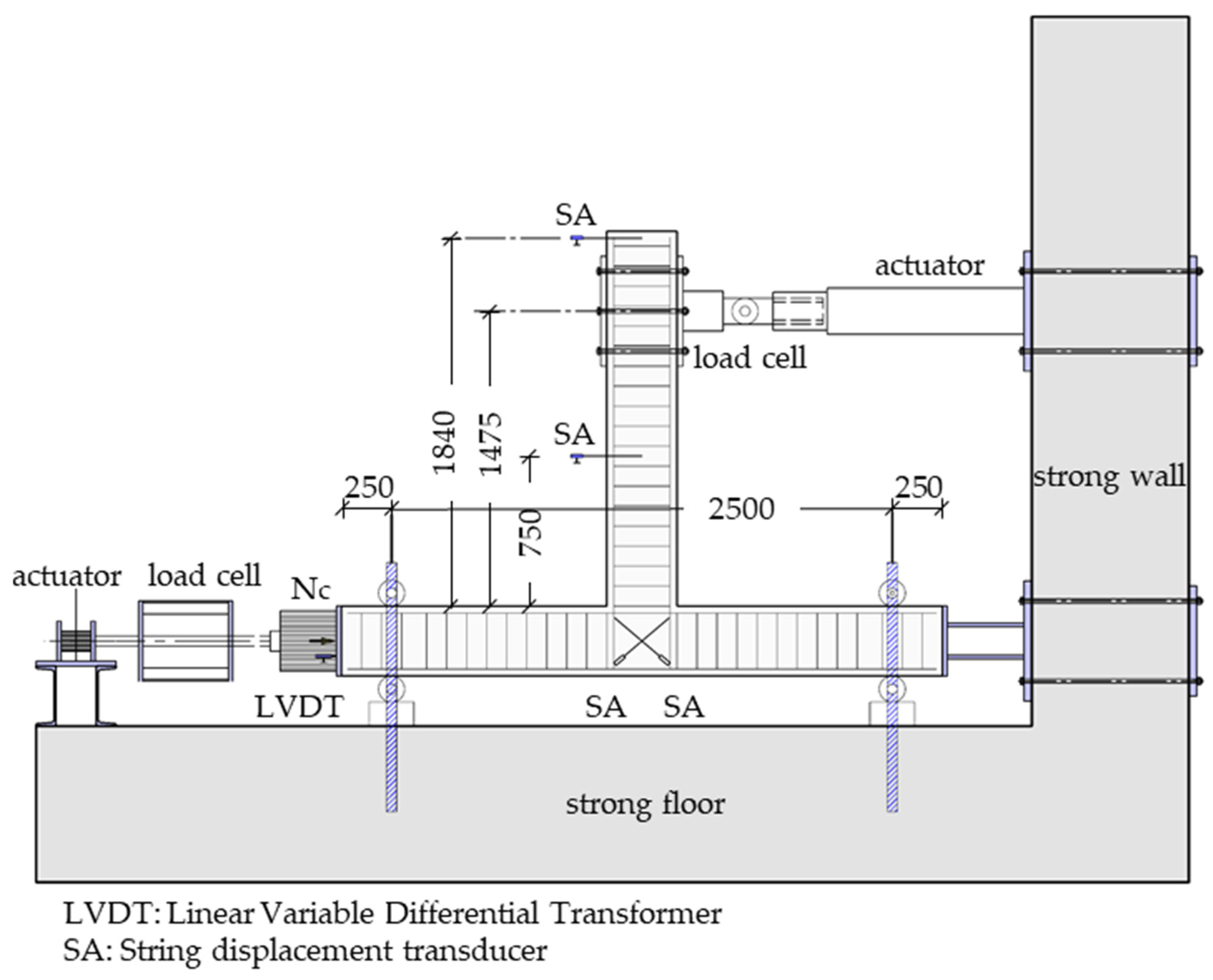


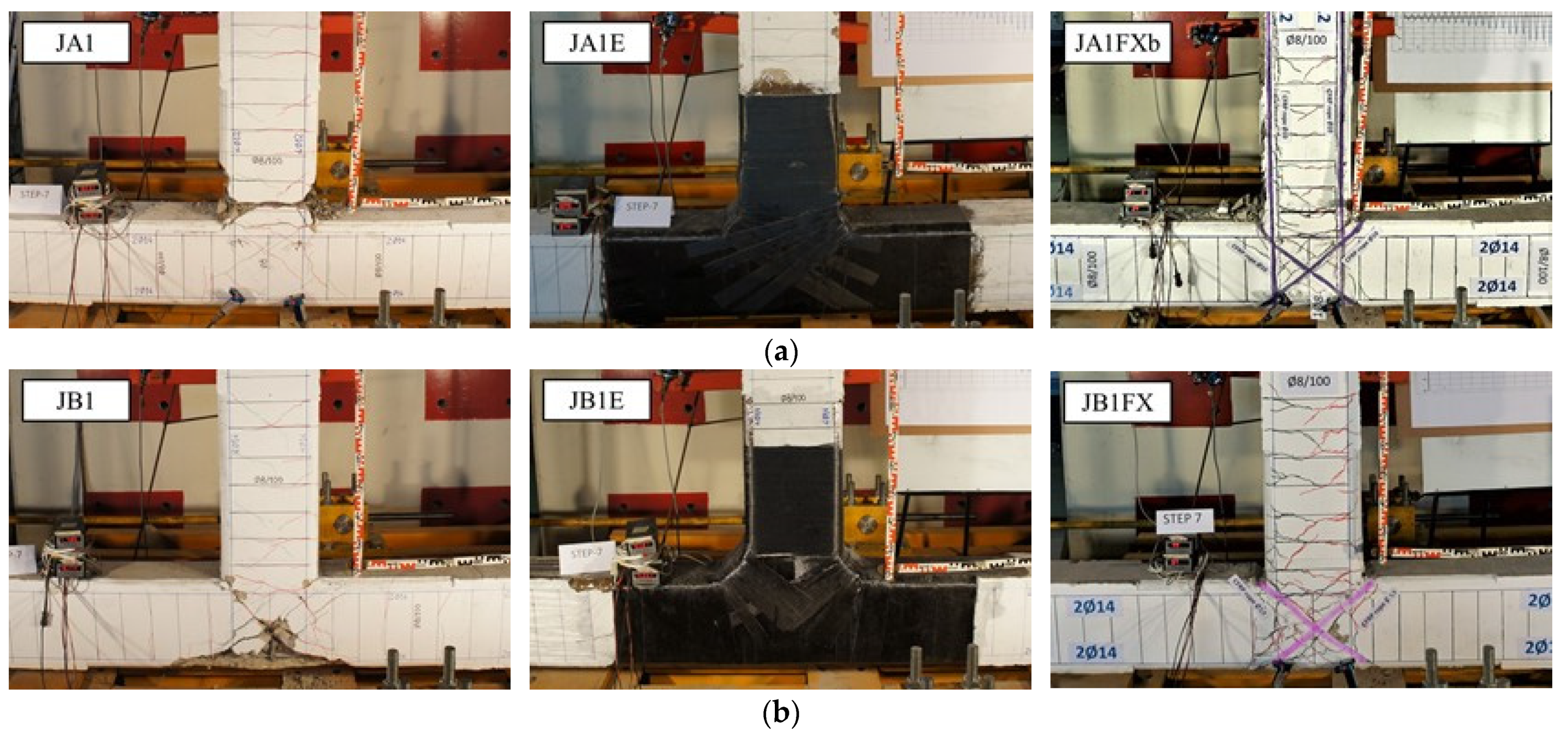
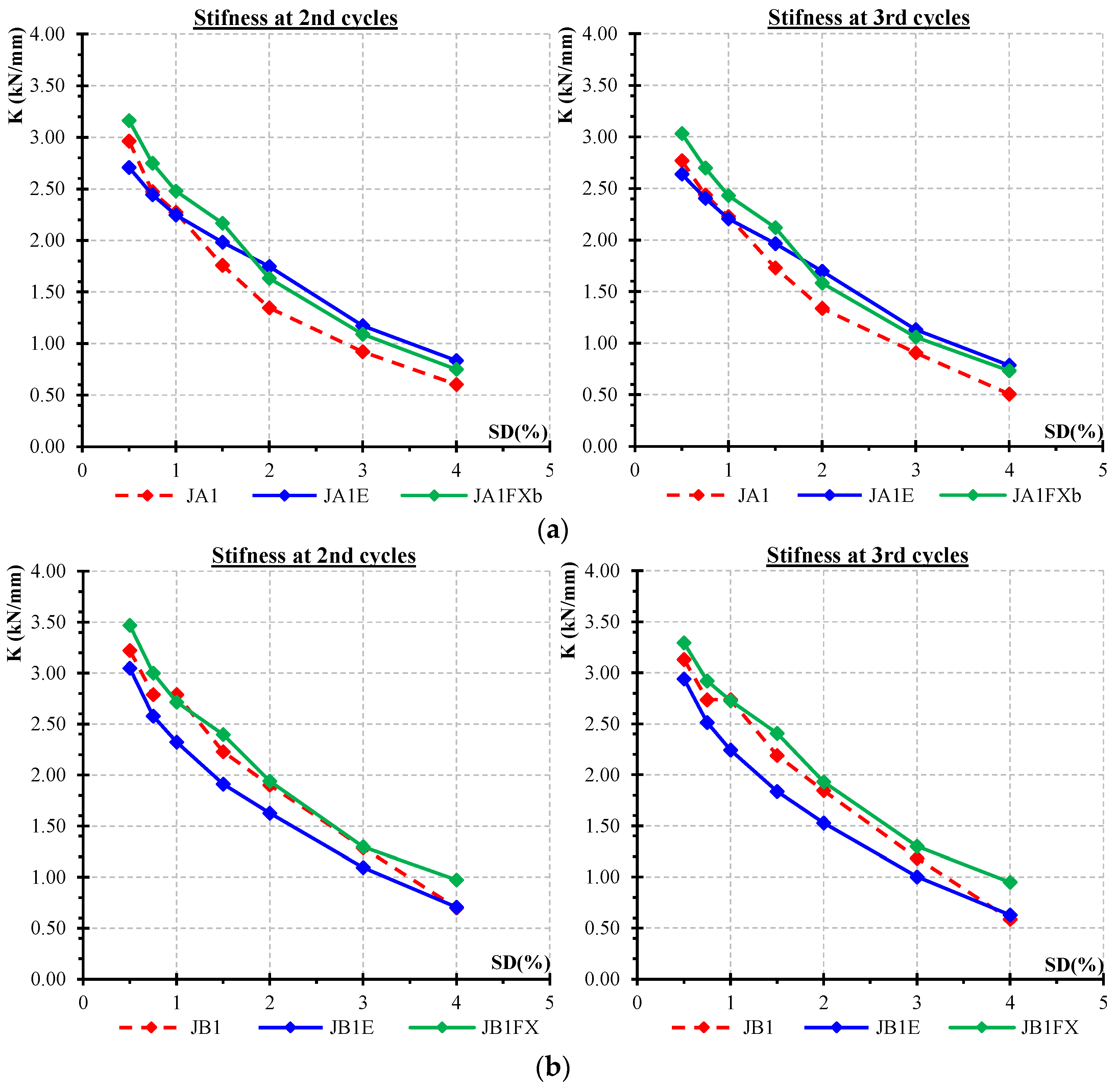
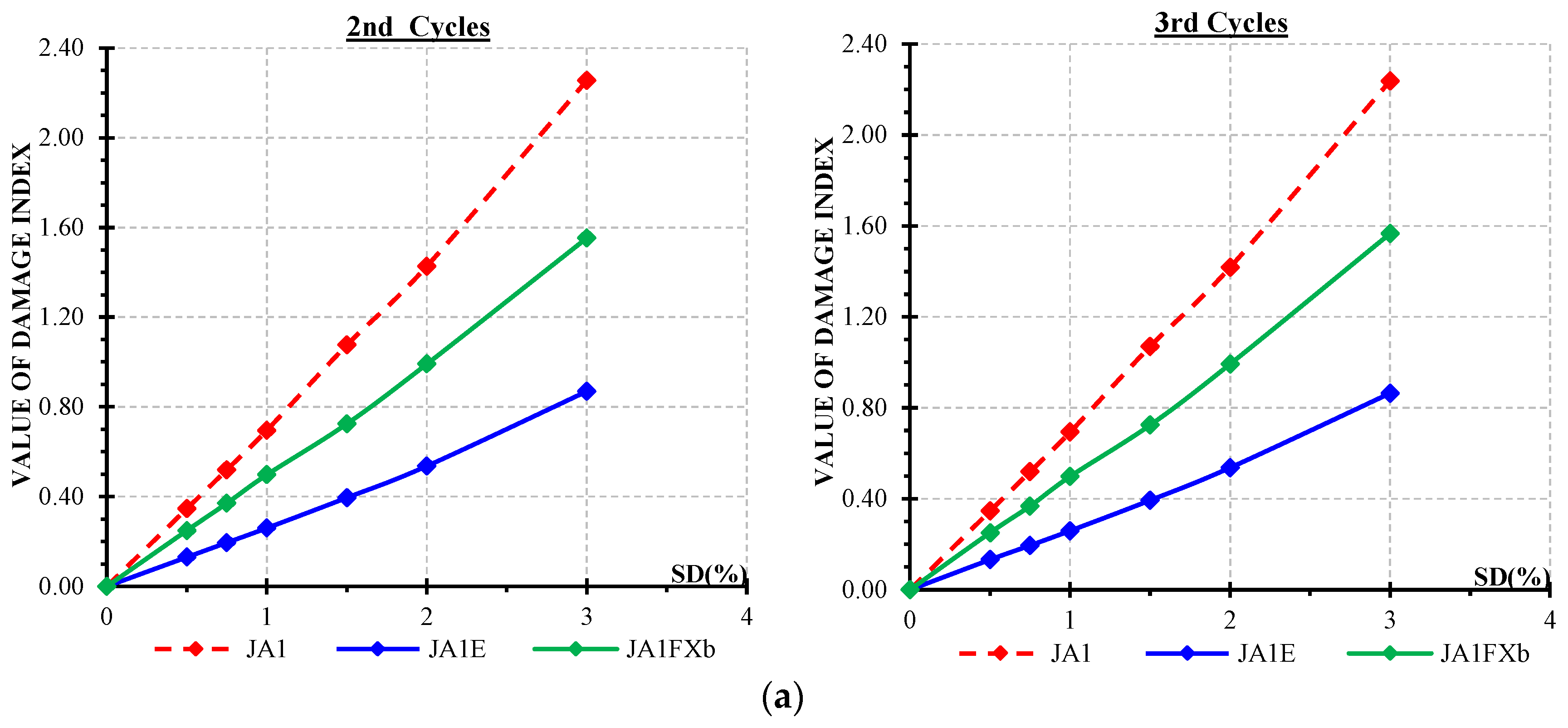
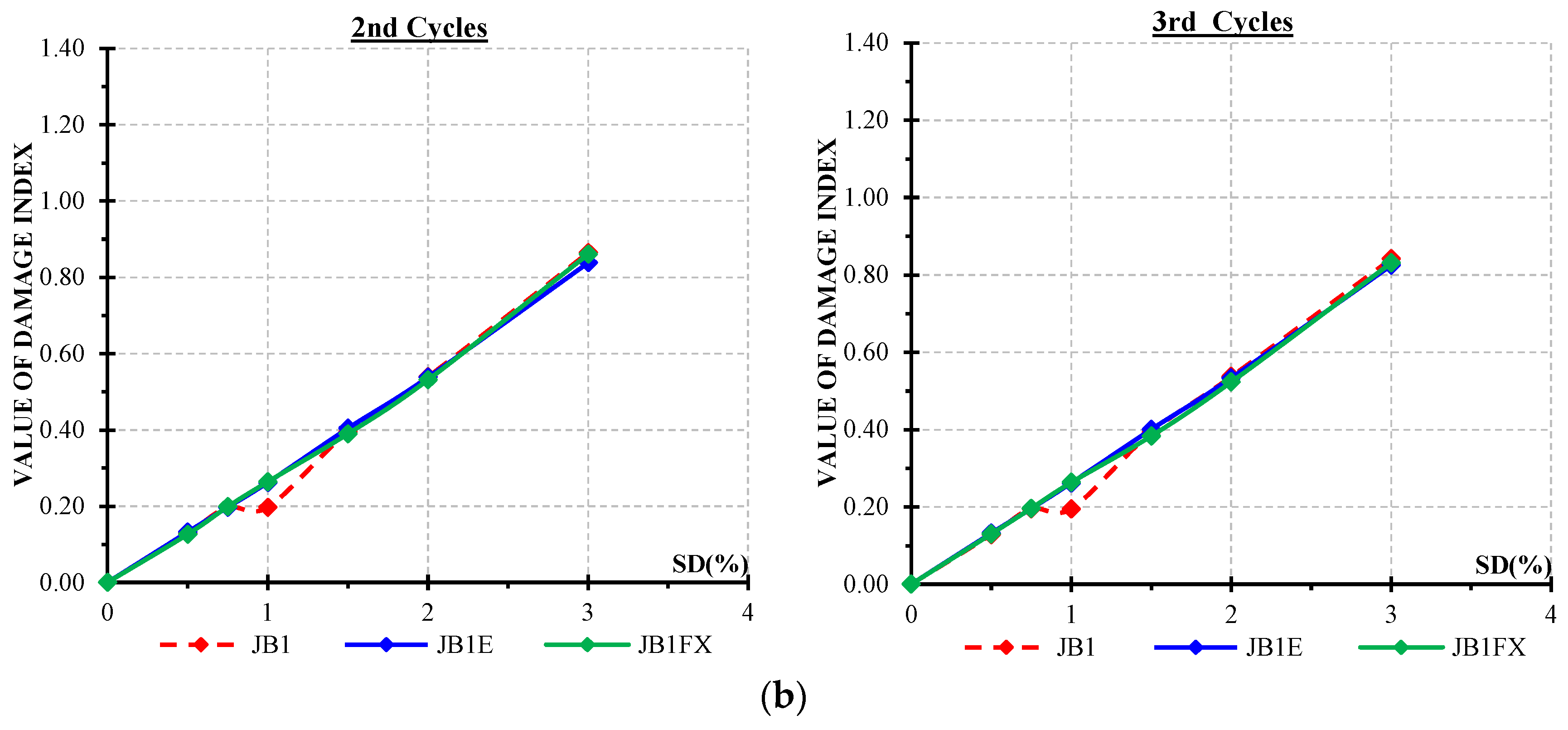

Publisher’s Note: MDPI stays neutral with regard to jurisdictional claims in published maps and institutional affiliations. |
© 2021 by the authors. Licensee MDPI, Basel, Switzerland. This article is an open access article distributed under the terms and conditions of the Creative Commons Attribution (CC BY) license (https://creativecommons.org/licenses/by/4.0/).
Share and Cite
Golias, E.; Zapris, A.G.; Kytinou, V.K.; Kalogeropoulos, G.I.; Chalioris, C.E.; Karayannis, C.G. Effectiveness of the Novel Rehabilitation Method of Seismically Damaged RC Joints Using C-FRP Ropes and Comparison with Widely Applied Method Using C-FRP Sheets—Experimental Investigation. Sustainability 2021, 13, 6454. https://doi.org/10.3390/su13116454
Golias E, Zapris AG, Kytinou VK, Kalogeropoulos GI, Chalioris CE, Karayannis CG. Effectiveness of the Novel Rehabilitation Method of Seismically Damaged RC Joints Using C-FRP Ropes and Comparison with Widely Applied Method Using C-FRP Sheets—Experimental Investigation. Sustainability. 2021; 13(11):6454. https://doi.org/10.3390/su13116454
Chicago/Turabian StyleGolias, Emmanouil, Adamantis G. Zapris, Violetta K. Kytinou, George I. Kalogeropoulos, Constantin E. Chalioris, and Chris G. Karayannis. 2021. "Effectiveness of the Novel Rehabilitation Method of Seismically Damaged RC Joints Using C-FRP Ropes and Comparison with Widely Applied Method Using C-FRP Sheets—Experimental Investigation" Sustainability 13, no. 11: 6454. https://doi.org/10.3390/su13116454
APA StyleGolias, E., Zapris, A. G., Kytinou, V. K., Kalogeropoulos, G. I., Chalioris, C. E., & Karayannis, C. G. (2021). Effectiveness of the Novel Rehabilitation Method of Seismically Damaged RC Joints Using C-FRP Ropes and Comparison with Widely Applied Method Using C-FRP Sheets—Experimental Investigation. Sustainability, 13(11), 6454. https://doi.org/10.3390/su13116454










